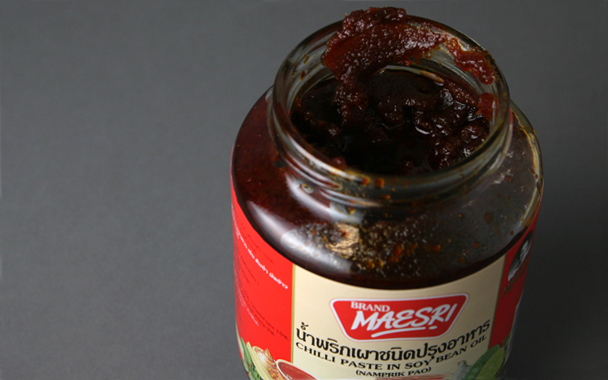My wife’s family has the tradition of never cooking the same Christmas dinner twice. In years past they’ve had meals ranging from the conventional (roast goose) to the somewhat more exotic (turkey mole one year; a Russian feast featuring an entire stuffed cabbage and cranberry kissel another). So when my sister-in-law starting dating Pakorn, who’d come to the States from Thailand as a boy, it seemed very much in the spirit of things for his mother, Tia, to bring Thai dishes to the Christmas table.
The first year she came, Tara and I wanted to cook up a welcoming storm and offered to make Thai food. “I eat Thai food all the time!” Tia exclaimed. “I want eggplant parmesan.” So we made an enormous Italian meal. But, like us, Tia sees every opportunity to cook as a chance to show affection, so she simultaneously made a second, elaborate Thai meal—satay and curries and noodle soups and shrimp omelettes. Tara and I, unused to being bossed around in our own kitchen, were worried about the excess of food and how the disparate dishes might clash, but it felt right, in the end, to share food we loved with people we were growing to love.
Siobhan and Pakorn got married this fall. It’s been a few years since we met Tia, and we’re more comfortable with each other now, so there’s a little less excess. This year I made nothing but a paella for Christmas dinner, offering a different take on ingredients (rice, seafood, sausage) common in Thai cuisine. And Tia made only summer rolls, and a hot and spicy shrimp salad. This year, too, she got Pakorn more involved in the cooking, and that salad was so good (and such a perfect, unexpected counterpoint to the rich paella) that I asked him how to make it. It turned out to be kind of an object lesson in Thai cooking, because constant tasting and a search for balance are the main techniques.
“You’d call that dish yam gung,” Pakorn told me. “Gung means shrimp, and yam is a hot, spicy salad, as opposed to a sauté or stir-fry. You cook the main ingredient simply—we just boiled those shrimp—then add the dressing ingredients a little bit at a time until you get that perfect mix of spicy hot, salty, sour and sweet.
“The dressing is made of a roasted chile paste called nam prik pao, for spicy and sweet; soy sauce for salt; and lime juice, thin-sliced kaffir lime leaves, and fine-chopped lemongrass for sour. There’s also some finely sliced red onion, scallions, and cilantro.
“We started with about a tablespoon of the nam prik pao, which we mixed with just enough lime juice and soy sauce to dissolve the paste. We added about half of it to the shrimp, along with a few big pinches each of onions, cilantro, lemongrass, and lime leaves. We tasted it, then added ingredients one by one, and kept tasting it again until we hit the perfect balance. When I told Mom it was ‘just spicy enough,’ she smiled and poured in the rest of the nam prik pao. When we’d brought it back into balance it was even better.”
Pakorn used fresh kaffir lime leaves from a plant his mother gave him, but you can usually find the leaves frozen in a Thai or other Asian grocery store. You’ll find nam prik pao there too.




 Pinterest
Pinterest


